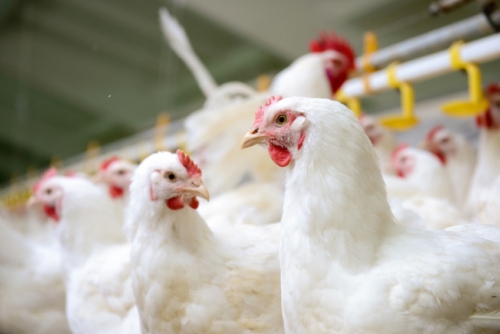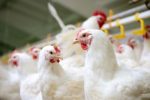
The emergence of the modern, fast-growing “broiler” chicken—the variety raised for food—is a triumph of selective breeding and cultivation.
However, Whole Foods has recently thrown its weight behind a plan by the Global Animal Partnership (GAP), which establishes farm animal welfare standards, to replace fast-growing broiler chickens with slow-growing ones within its standards. Since Whole Foods takes its cues in what meat to buy from GAP, this means that anyone who wants to keep serving as a chicken supplier to the restaurant chain needs to make the shift as well.
Broiler Chickens: Quick Facts
- Fast-growing broiler chickens are those that have been selectively bred to create breeds that build muscle mass quickly.
- This allows broilers to be raised and sold quickly; giving customers more meat for less money and which helped popularize chicken in the American diet.
- In broilers that don’t get sold and are used for breeding, this mass ends up causing skeletal and muscle difficulties that can leave them immobile in 15-30% of cases.
This weight problem and the associated issues means farmers are forced to place breeding boilers—they are restrictive diets that keep them from getting too fat to reproduce.
Unfortunately, the diets don’t address the underlying skeletal or muscle problems and leave the chickens perpetually hungry. For those who care about animal welfare, this is not a good situation.
The GAP Changes
The specific change GAP intends to make is requiring chickens to be from breeds with an average growth rate of 50 grams or less per day. This is about 23% less than most fast-growing broilers, effectively requiring their abandonment in favor of slow-growing chickens as the standard is phased in over the next eight years.
Other changes GAP is making to its standards include requiring each chicken to have 25% more floor space than previous versions and for additional provisions which include adding natural light, straw bales, perches, and other amenities.
Impact For You
If you are one of the 600 or so chicken farms in the United States that follows the GAP standards, this change is going to end up costing a fair bit of time and money.
Not only will existing breeds need to be abandoned and new ones obtained, but the additional feed required by slower growing chickens will impose additional costs. If you are a consumer who buys chicken from Whole Foods or any other retailer that uses GAP farms, you are likely to see a price increase at the checkout line. Exactly how much the price of chicken is going to rise as a result of these changes remains to be seen.
Sources:
“Our Commitment to Improving Bird Welfare With 100% Slower-Growing Chicken Breeds,” Global Animal Partnership web site, March 17, 2016; http://www.globalanimalpartnership.org/about/news/post/our-commitment-to-improving-bird-welfare-with-100-slower-growing-chicken-breeds, last accessed March 30, 2016.
Charles, D., “Why Whole Foods Wants a Slower-Growing Chicken,” NPR web site, March 30, 2016; http://www.npr.org/sections/thesalt/2016/03/30/472167748/why-whole-foods-wants-a-slower-growing-chicken, last accessed March 30, 2016.













